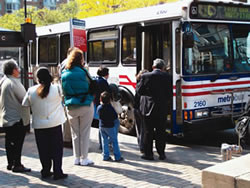About This Guide
This guide is intended to provide transit agency staff with an easy-to-use resource for improving pedestrian safety. It should prove useful for transit staff who set agency policies, monitor transit performance, determine transit stop locations and schedules, train transit operators, and work with communities on development near transit stations. The guide is also a resource for agency staff who work with other transportation agencies to develop safe access and egress for transit passengers.

 The primary goal of transit providers is to carry passengers between residences, employment and other destinations in a safe, convenient, efficient and reliable manner.
The primary goal of transit providers is to carry passengers between residences, employment and other destinations in a safe, convenient, efficient and reliable manner. Transit agencies play an important role in improving the safety of pedestrians. Providing safe and comfortable routes to and from transit improves the passenger experience and helps transit agencies maximize ridership and customer satisfaction.
Transit agencies play an important role in improving the safety of pedestrians. Providing safe and comfortable routes to and from transit improves the passenger experience and helps transit agencies maximize ridership and customer satisfaction.